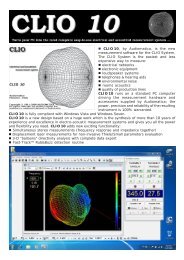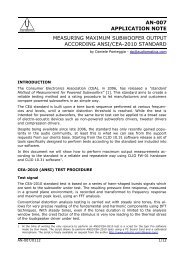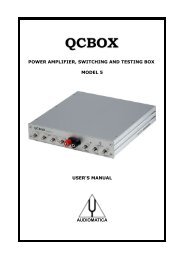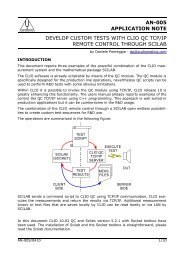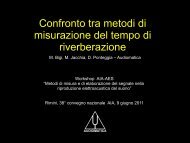CLIOwin 7 PCI User's Manual - Audiomatica
CLIOwin 7 PCI User's Manual - Audiomatica
CLIOwin 7 PCI User's Manual - Audiomatica
You also want an ePaper? Increase the reach of your titles
YUMPU automatically turns print PDFs into web optimized ePapers that Google loves.
9.2.1 TOOLBAR BUTTONS, DROP DOWN LISTS AND DISPLAYS<br />
Starts an FFT measurement. Right-clicking on it you open the associated drop down<br />
menu where it is possible to select the Continue switch. In this mode the<br />
measurement is not started from blank but accumulates with the previously stopped<br />
one; see Averaging (9.6) for details.<br />
Stops the current measurement.<br />
Enters the FFT Settings dialog box.<br />
Enables the Time Data display. The second graph that is activated behaves as an<br />
oscilloscope and displays the captured waveform correspondant to the last FFT<br />
analysis.<br />
Enables the Hold function. Depending on the setting entered in the FFT Settings dialog<br />
box, it is possible to hold either the minimum or maximum value per frequency point.<br />
Moves the equal loudness curve up of 1phon. See also 9.5.<br />
Moves the equal loudness curve down of 1phon. See also 9.5.<br />
data window<br />
Selects a weighting data window among the following:<br />
- Rectangular (no window)<br />
- Hanning<br />
- Hamming<br />
- Blackman<br />
- Bartlett (triangular)<br />
- FlatTop<br />
channel display<br />
Selects the input channel to display among the following:<br />
- Channel A only<br />
- Channel B only<br />
- Channel BAL (two channels used in balanced configuration)<br />
- Channel A&B (both channels displayed in different graphs)<br />
Y scale units<br />
Selects the measurement units among the following:<br />
- dBV<br />
- dBu<br />
- dBRel (with respect to the global reference level; see chapter 8)<br />
- dBSPL (for acoustical measurements)<br />
frequency smoothing<br />
Selects the frequency smoothing in fractions of octave from 1/48 to 1/2 of octave.<br />
target averages<br />
Inputs the total number of averages. Averaging is controlled by the setting in the FFT<br />
Settings dialog; see Averaging (9.6) for details.<br />
number of averages display<br />
Displays the number of the actual average; this number increases during the<br />
measurement unless, while in exponential averaging, the target has already been<br />
reached; see Averaging (9.6) for details.<br />
94 Chapter 9 - FFT








